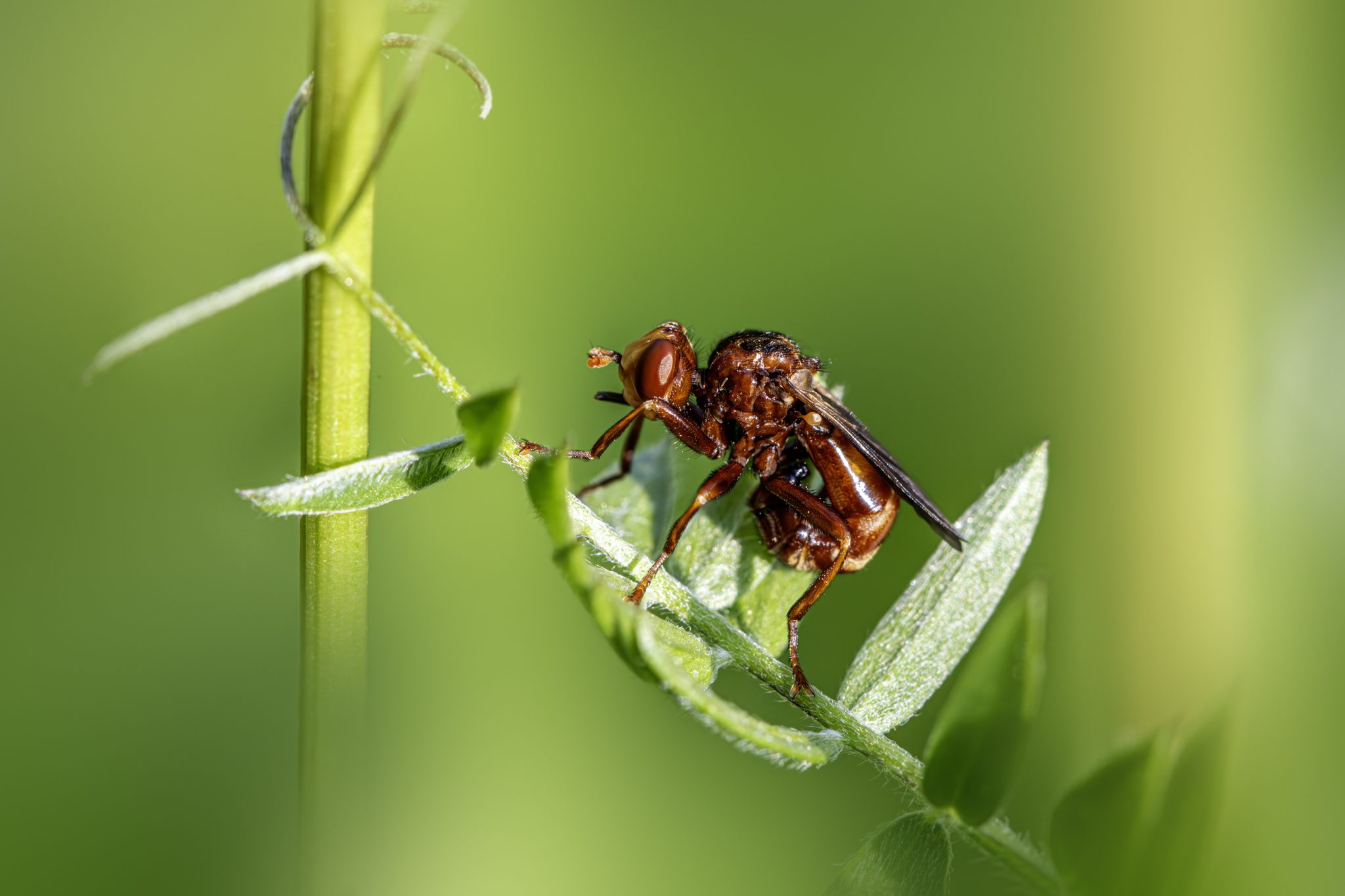Here’s a complete natural history and identification overview of the Ferruginous Bee-grabber (Sicus ferrugineus), a striking parasitic fly commonly found in Europe’s meadows and hedgerows. 🐝🪰
🪰 Ferruginous Bee-grabber (Sicus ferrugineus)
Family: Conopidae (Thick-headed Flies)
Genus: Sicus
Common name: Ferruginous Bee-grabber, Thick-headed fly
🌍 General Overview
The Ferruginous Bee-grabber (Sicus ferrugineus) is a medium-sized, reddish-brown parasitic fly found throughout much of Europe and temperate Asia.
It is one of the most widespread and recognizable members of the Conopidae family, known for its bee-mimicking appearance and parasitic lifestyle — the larvae develop inside bumblebees (Bombus spp.), eventually killing the host.
This mimicry allows the fly to approach its hosts without alarming them, making it a remarkable example of aggressive mimicry in the insect world.
🧬 Identification
| Feature | Description |
|---|---|
| Length: | 10–13 mm |
| Color: | Entirely ferruginous (rusty reddish-brown) with some darker markings on abdomen |
| Head: | Broad with a strongly downcurved face; black eyes |
| Antennae: | Short and thick, forward-pointing |
| Thorax: | Smooth and shiny reddish-brown |
| Abdomen: | Pear-shaped, bulbous, and strongly curved downwards — a distinctive feature |
| Legs: | Reddish to orange, relatively long |
| Wings: | Clear with slightly darkened veins, held flat over the body when resting |
🆔 Key ID features:
- Entirely reddish-brown body
- Curved, swollen abdomen (unique within the genus)
- Bee-like appearance and behavior around flowers
🌸 Behavior and Ecology
- Activity period: Adults fly from May to September, peaking in mid-summer.
- Habitat: Found in flower-rich meadows, hedgerows, woodland edges, and gardens.
- Feeding (adults): Visit flowers for nectar — especially thistles (Cirsium, Carduus), knapweeds (Centaurea), and scabious (Knautia, Scabiosa).
- Flight pattern: Strong, hovering flight; often seen around bumblebees and flower heads.
🪺 Life Cycle
| Stage | Description |
|---|---|
| Egg laying: | Females attack bumblebees in flight or on flowers; insert an egg into the bee’s abdomen using a sharp ovipositor. |
| Larvae: | Develop as endoparasites inside the bee, feeding on its internal tissues. |
| Pupation: | After killing the host, larvae pupate within the bee’s nest. |
| Overwintering: | Occurs as a pupa within the host’s nest or surrounding soil. |
| New adults: | Emerge the following spring or early summer. |
🧠 Hosts: Mainly bumblebees (Bombus spp.), including:
- Bombus terrestris (Buff-tailed bumblebee)
- Bombus lapidarius (Red-tailed bumblebee)
- Bombus pascuorum (Common carder bee)
🌲 Habitat
- Preferred environments:
- Flower-rich grasslands
- Woodland clearings and edges
- Roadside verges
- Gardens with abundant wildflowers
- The presence of bumblebee populations is crucial for this species’ survival.
🧭 Distribution
- Range:
Widespread across Europe, from the British Isles and Scandinavia south to the Mediterranean, and east through Russia to western Asia. - In northern Europe: Common in lowlands and moderate altitudes; less frequent in mountain zones.
📉 Conservation Status
| Category | Details |
|---|---|
| IUCN Red List: | Not evaluated globally; common and stable in most of Europe |
| Population trend: | Stable, though dependent on healthy bumblebee populations |
| Threats: | Pesticide use, habitat loss, and decline in wildflower meadows |
| Conservation notes: | Benefited by conservation of pollinator habitats and flower-rich ecosystems |
🧠 Interesting Facts
- The genus name Sicus comes from Greek sikos (“fig”), likely referring to the species’ bulbous abdomen.
- Despite its parasitic nature, it plays a role in flower pollination, since adults regularly visit flowers.
- Females can insert eggs into a bee’s abdomen in less than one second — a highly specialized adaptation.
- It is harmless to humans and other insects apart from its specific bee hosts.
📊 Summary Table
| Trait | Description |
|---|---|
| Scientific name | Sicus ferrugineus |
| Common name | Ferruginous Bee-grabber |
| Family | Conopidae |
| Length | 10–13 mm |
| Color | Rusty reddish-brown |
| Activity | May–September |
| Host | Bumblebees (Bombus spp.) |
| Larval behavior | Internal parasite |
| Habitat | Meadows, hedgerows, woodland edges |
| Distribution | Europe to W. Asia |
| Status | Common, stable populations |
Views: 186
Subscribe to the newsletter:
